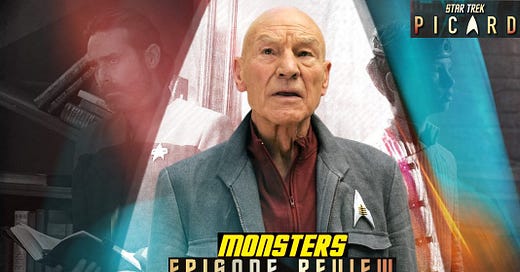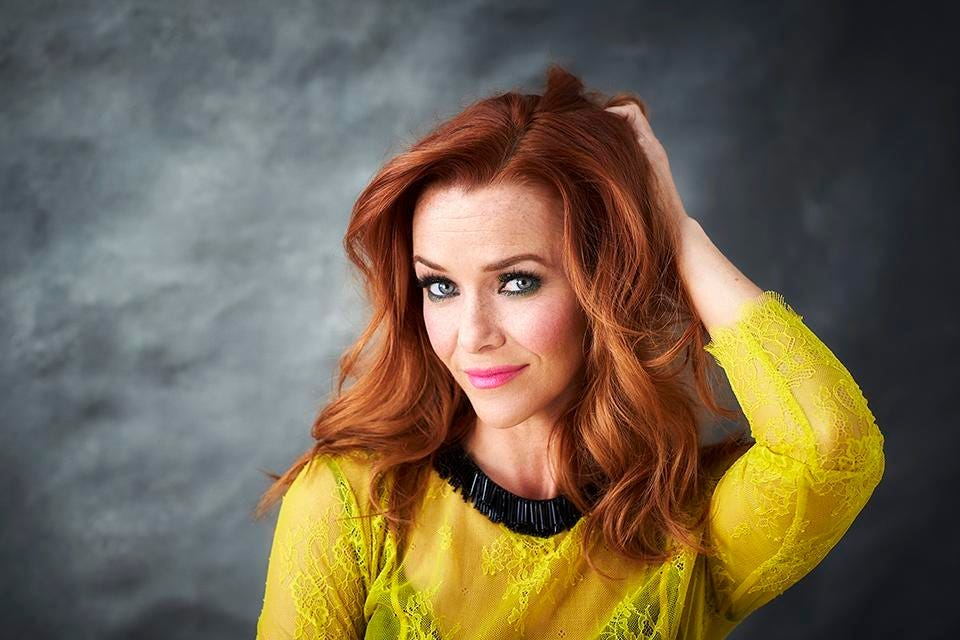Note to The Vestibule’s subscribers: News of Annie Wersching’s death reached me just as I was finishing this review of Star Trek: Picard’s “Monsters” (Season 2, Episode 7). Her passing is a tremendous shock, so I offer my condolences to Wersching’s family, friends, and colleagues.
That such a vibrant and terrific artist can succumb to cancer at the age of 45 tempts me to bemoan life’s innate unfairness, but, instead, I choose to celebrate the career of a woman born and raised in one of my favorite places on Earth: St. Louis, Missouri.
Wersching’s death is an immense loss for lovers of great acting in general, but for Star Trek fans in particular. In 1999, Wersching graduated with a Bachelor of Fine Arts degree in musical theatre from Decatur, Illinois’s Millikin University, then made her professional television debut as “Liana” in Star Trek: Enterprise’s Season 1 episode “Oasis.” First broadcast on 3 April 2002, this installment sees Wersching cast as the daughter of a character named Ezral, played by the late-great René Auberjoinois (1940-2019), best known to Trek fans as Deep Space Nine’s security chief, Constable Odo.
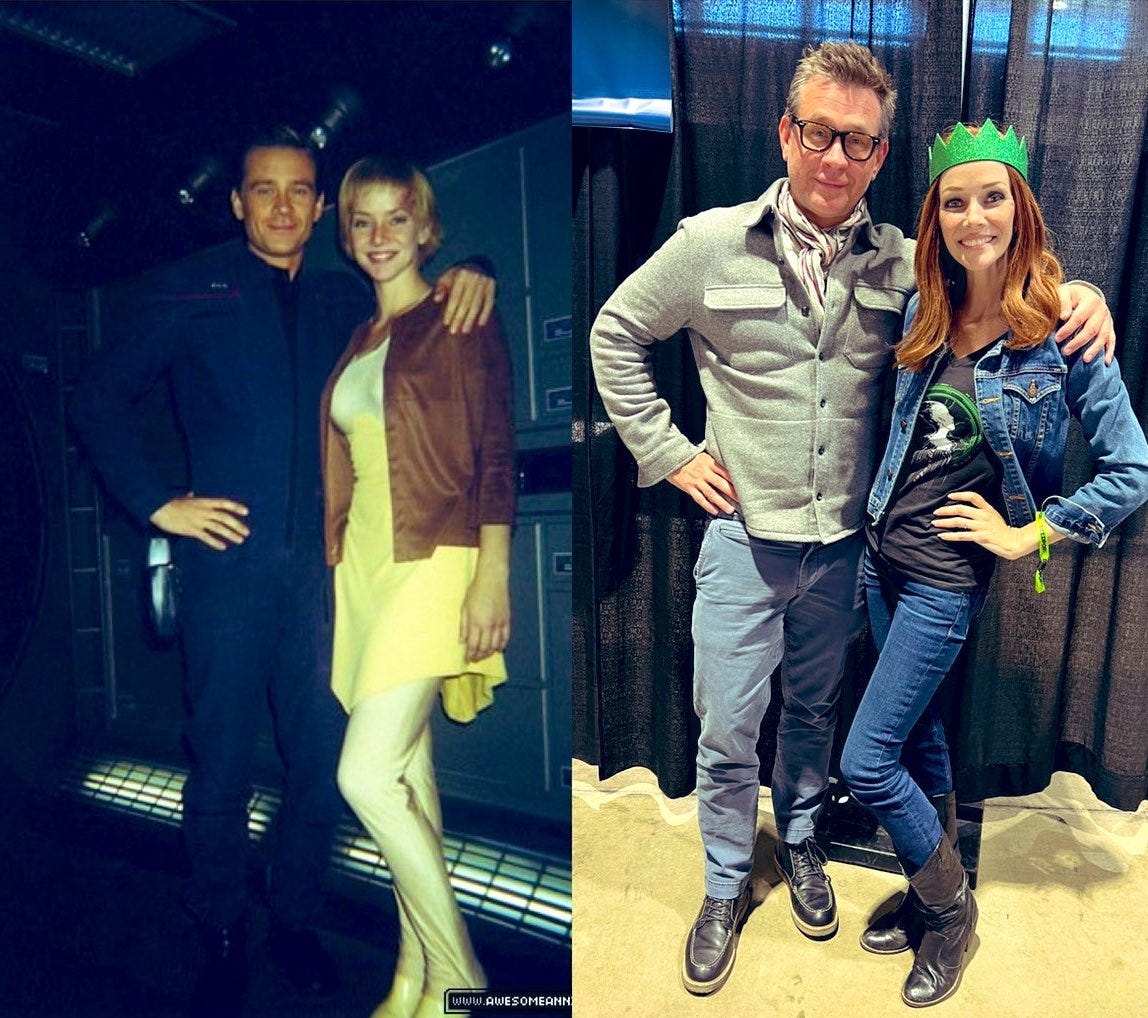
Wersching blazed a trail of terrific appearances after Enterprise, with her work as FBI Agent Renee Walker in Seasons 7 and 8 of Joel Surnow’s & Robert Cochran’s real-time counterterrorist thriller 24 (2001-2010) ranking among the best American television performances of the 21st Century’s opening decade.
Wersching’s work as villainous time-traveller Emma Whitmore in Eric Kripke’s & Shawn Ryan’s Timeless (2016-2018) is pure gold, while her roles as Officer Julia Brasher in the first season of Michael Connelly’s & Eric Overmyer’s Los Angeles cop drama Bosch and as the extraterrestrial arms-trader-turned-Hollywood-actor Leslie Dean in every episode of Stephanie Savage’s & Josh Schwartz’s Marvel Comics adaptation Runaways are distinct, powerful, and well-worth watching (or rewatching).
Then, in a triumph of come-home casting, Wersching returned to the Trek franchise to play the Borg Queen throughout Season 2 of Star Trek: Picard. Readers of my Picard reviews know how highly I rate Wersching’s commitment to this role. She’s marvelous, making the Queen a unique personality despite inheriting the part from two brilliant predecessors, Alice Krige (who originated the Queen in 1996’s feature film Star Trek: First Contact) and Susanna Thompson (who not only played the Queen in Star Trek: Voyager’s later seasons but also, in a happy bit of Hollywood synchronicity, shared several cracking Timeless scenes with Wersching).
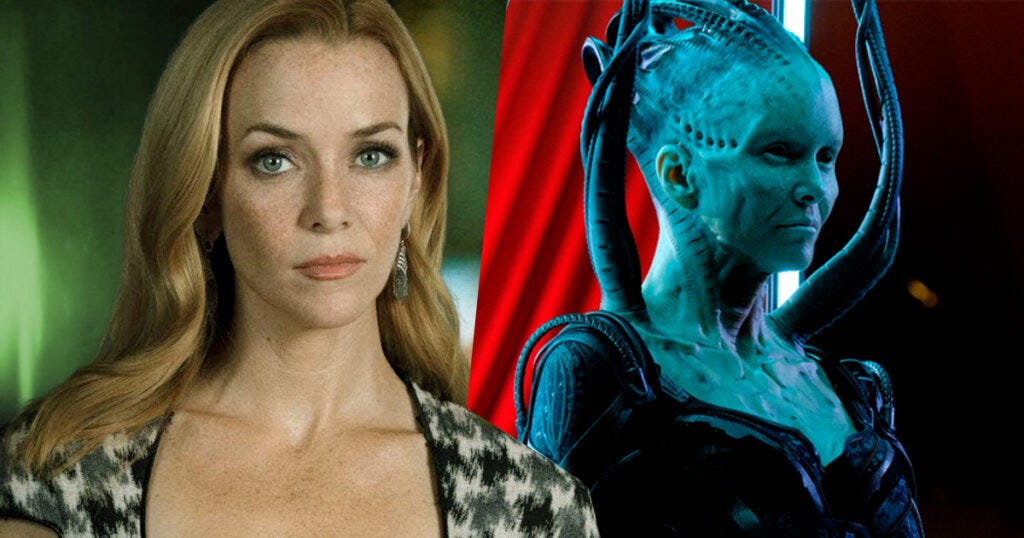
I’ll praise Wersching again in my review of Episode 9 (“Hide and Seek”), but, for now, let’s salute the life of a Star Trek family member who left us much too soon. Thanks to the excellent and extensive oeuvre Wersching amassed during two decades of exceptional acting, it’s at least a small comfort to know she’ll always be with us.
Annie Wersching, it goes without saying (but let’s say it anyway), was a wonderful performer and, by all reports, a fabulous human being.
May she rest in perfect peace.
Star Trek: Picard
“Monsters”
Season 2, Episode 7
Written by Jane Maggs
Directed by Joe Menendez
Starring Patrick Stewart, Orla Brady, Michelle Hurd, Alison Pill, Jeri Ryan, and Santiago Cabrera
Guest Starring Ito Aghayere, James Callis, Steve Gutierrez, Jay Karnes, Sol Rodriguez, Dylan Von Halle, and Madeline Wise
47 minutes
Original broadcast 14 April 2022
1. Off the Chain
Describing Star Trek: Picard’s second season as a serialized story shouldn’t imply that it travels a single, bullet-like path. Among Picard Season 2’s best qualities is how, even during installments barely crossing the 30-minute mark, the program takes enough time to meander from place to place and plot to plot, resembling nothing so much as a curious sightseer finding hidden alleys, unseen byways, and foreign locales whose existence was, until now, secret.
The point of these mixed similes is to commend Season 2 for embracing the Trek franchise’s episodic roots while reveling in the forward momentum that serialization permits. Fusing both narrative types is hardly new for American television, as soap-opera devotees have long known, or for Star Trek, with the franchise blending these fictional styles as far back as the 1970s, when The Animated Series (aka TAS, 1973-1974) returned subsidiary characters (including Harry Mudd; Cyrano Jones and his tribbles; Spock’s parents, Amanda Grayson and Sarek; and even the sentient time machine known as the Guardian of Forever)—alongside their associated subplots—to television years after their first appearances in The Original Series (aka TOS, 1966-1969) to fashion an internal continuity that creator Gene Roddenberry and chief TAS writer Dorothy C. Fontana fretted over only as much as required by their interest in establishing the Trek universe as a place where the tenets of good storytelling, at least as Roddenberry saw them, shouldn’t be slavishly restricted by what had gone before.1
Even so, The Original Series and its first four live-action offshoots (1987-1994’s The Next Generation, 1993-1999’s Deep Space Nine, 1995-2001’s Voyager, and 2001-2005’s Enterprise) differ from Picard and its ongoing “New Trek” siblings (Discovery, Lower Decks, Prodigy, and Strange New Worlds) in one significant respect: the older shows produced at least 22 episodes every season (with TOS offering a whopping 29 episodes in its first two years on NBC) rather than the shorter, 8- to 15-episode runs once exclusively associated with basic- and premium-cable series such as Tom Fontana’s Oz (1997-2003), David Chase’s The Sopranos (1999-2007), and Shawn Ryan’s The Shield (2002-2008), to say nothing of the British Broadcasting Corporation (BBC) and other European networks, whose narrative model has depended upon shorter seasons (with heftier episode runtimes) for at least 50 years.
These longer seasons allow “Legacy Trek” (or, simply, “Classic Trek”—i.e., everything produced between 1966 and 2005) to amble leisurely through several different, self-contained installments that nonetheless build character, plot, and theme over extended spans, perhaps more haphazardly than the straighter-shot storytelling preferred by the current crop of serialized shows, but still permitting what seems like organic growth—again, in character, plot, and theme—no matter how carefully planned these elements might be.
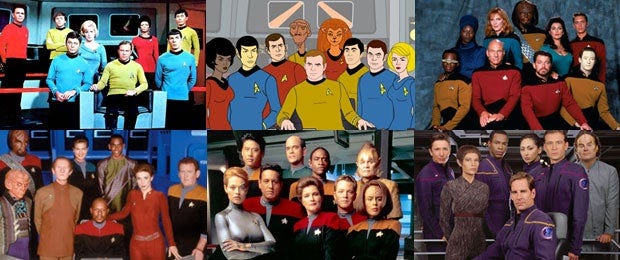
The Next Generation, for instance, features its share of stories that imperil the Federation, the galaxy, and, in the direst instances, history itself, yet also includes pleasant diversions in which the crew of the U.S.S. Enterprise-D enjoys hijinks unconnected to the fate of the universe, with Picard himself, in Season 3’s “Captain’s Holiday,” taking a vacation to the pleasure planet Risa that’s little more than an excuse for Jean-Luc to enjoy sexy times with Jennifer Hetrick’s marvelous, profit-seeking archaeologist Vash,2 while, in Season 4’s “Data’s Day,” the series devotes an entire segment to the day-in-the-life antics of Brent Spiner’s android officer.
Deep Space Nine regularly includes plots, subplots, and entire episodes that recount Operations Chief Miles O’Brien’s (Colm Meaney’s) growing friendship with Dr. Julian Bashir (Alexander Siddig). They play darts together in the bar owned by Armin Shimerman’s Ferengi entrepreneur Quark, they enjoy occasional games of racquetball (as seen in Season 2’s “Rivals”), and, especially, they indulge their shared passion for human history by participating in holosuite programs that include the Battles of Britain and, most famously, the Alamo.
O’Brien and Bashir aren’t averse to enjoying the pleasures of fiction, either, with Season 4’s “Our Man Bashir” revolving around a delightful, James Bond-inspired holographic adventure that casts Bashir as a superspy and O’Brien as one of his opponents. DS9’s vaunted long-running story arcs, in other words, don’t interfere with this program strolling hither and yon whenever the impulse seizes its writing staff.
Voyager develops its own fascination with holographic entertainments, to the point that its entire crew gets caught up in Helmsman Tom Paris’s Flash Gordon- and Buck Rogers-inspired Captain Proton adventure during Season 5’s enchanting “Bride of Chaotica!,” which sees Kate Mulgrew’s redoubtable Captain Kathryn Janeway chewing this segment’s glorious, black-and-white scenery after assuming the role of “Queen Arachnia” to ensure that Paris’s program eventually deactivates.
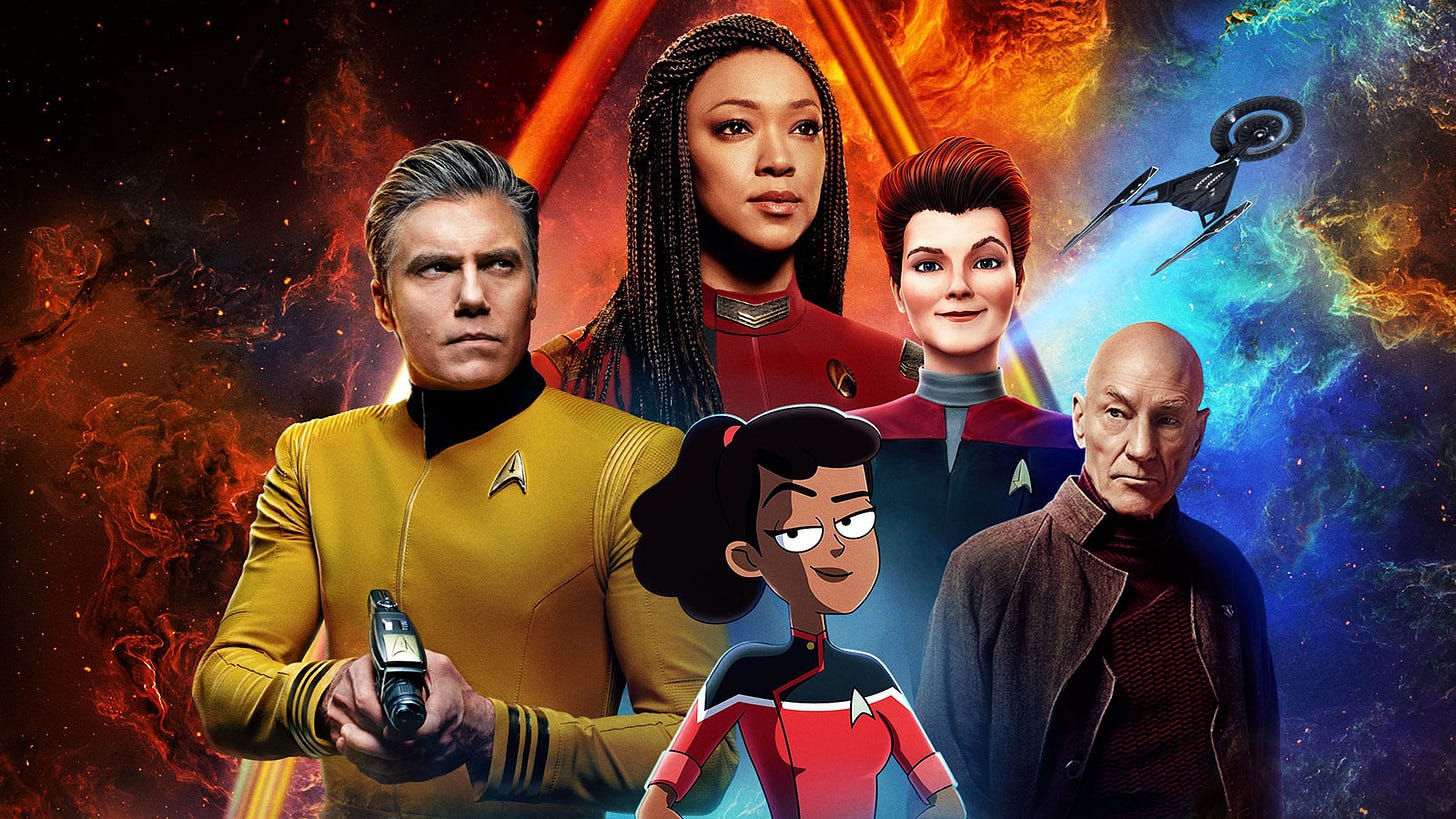
The good captain later falls in love with a holographic Irish barman living in the titular village of Season 6’s “Fair Haven,” another Paris-created holodeck amusement that, despite the fan skepticism this premise provoked after its 12 January 2000 broadcast, returns six outings later in a sequel installment titled “Spirit Folk.” Voyager, indeed, loves off-kilter segments that dovetail with the program’s (and starship’s) primary mission of returning home (after being flung 75,000 light years away from Federation space) by devoting a small-yet-significant portion of each season’s 25 or 26 episodes to chronicling its crew’s quirky methods of making this long-term journey not merely tolerable, but, indeed, enjoyable.
And who can forget that Enterprise, early in its second season, spends “A Night in Sickbay,” with Scott Bakula’s genial Captain Jonathan Archer witnessing the peculiar nighttime routines of John Billingsley’s eccentric Dr. Phlox as Archer stands vigil for his beagle Porthos, who, while accompanying Archer to the surface of an extraterrestrial planet, contracts an alien pathogen that Phlox must cure before the poor pooch dies? “A Night in Sickbay” is not only better than its harshest detractors suggest but also demonstrates how some Classic Trek episodes happily ramble, roam, saunter, and sashay their way through seasons that, relieved of the pressure of advancing a single story in the concentrated doses that typify the New Trek seasons we’ve watched on Paramount+ (formerly CBS All Access) since Discovery’s September 2017 premiere, permit more breathing room for—and, crucially, more time with—our favorite characters.
The supposedly bad old days of one-and-done, run-and-gun episodic television, in other words, embrace narrative possibilities and storytelling pleasures that American television’s now quarter-century project of ushering serialization from the wilderness of daytime soaps into the civilization of primetime dramas sometimes forgets, if not actively denigrates.
The notion of telling a single story across the span of an entire season is, of course, a cheat and a lie insofar as even relentlessly serialized shows like Joel Surnow’s & Robert Cochran’s 24 (2001-2010 & 2014), David Simon’s The Wire (2002-2008), Hwang Dong-hyuk’s Squid Game (2021-Present), and Tony Gilroy’s Andor (2022-Present) include subplots tangential to their main storylines’ forward thrust to offer a variety of tones, themes, and tempos that relieve the stultifying sameness that threatens to creep into any long-form narrative project, whether Trek’s six-decade-long (and counting!) franchise, Ann Radcliffe’s doorstop Gothic novels (1794’s The Mysteries of Udolpho, for example, stretches over four volumes and 600 pages), or Herman Melville’s seemingly interminable 1851 novel Moby-Dick (a text that, despite its classic status, a friend and fellow literature-professor colleague once described as “400 pages of exposition and 50 pages of plot”).
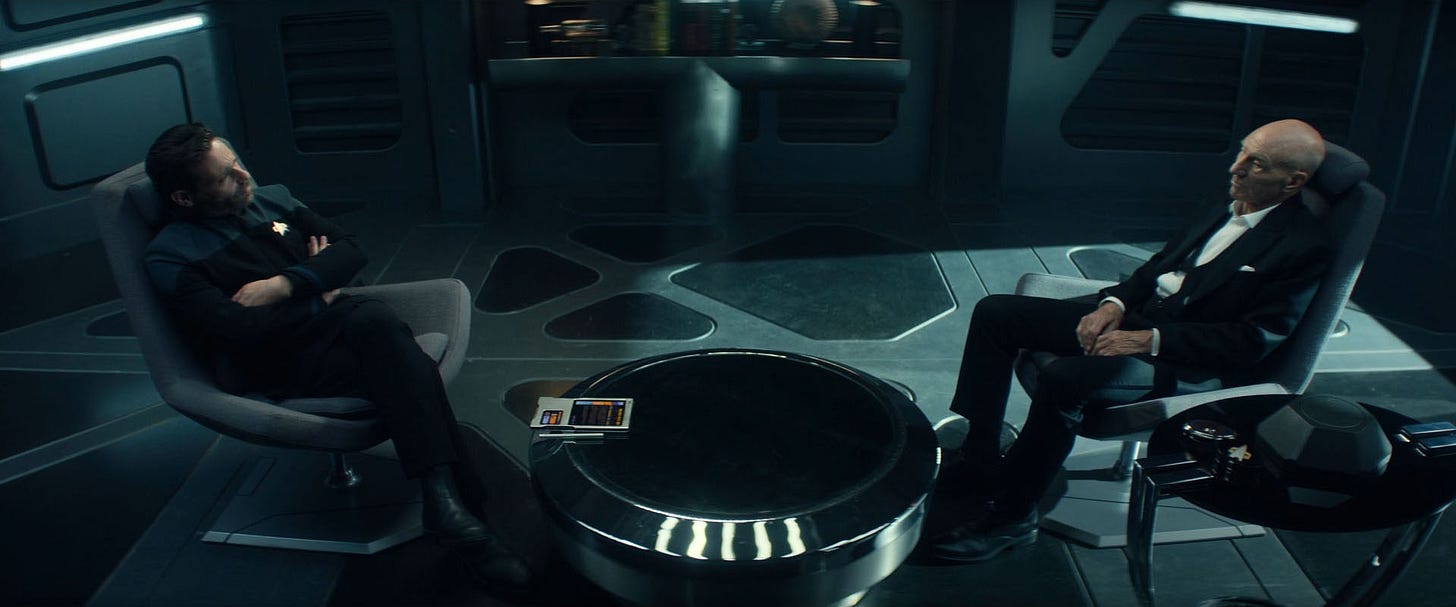
2. On the Couch
With these provisos in mind, we can begin appreciating the challenges that writer Jane Maggs faces when fashioning “Monsters” into an installment that weaves Picard Season 2’s various threads into a cohesive whole. Most, but not all, these strands compel Episode 7 to continue this season’s primary storyline of Jean-Luc Picard (Sir Patrick Stewart) and his La Sirena compatriots returning to 2024 Los Angeles to prevent an alternate timeline that finds the fascistic Confederation of Earth—first seen in Episode 2 (“Penance”)—overwriting the existence of the United Federation of Planets to place the fate of humanity and, indeed, the entire galaxy in jeopardy.
That Maggs performs this task as well as she does is notable, especially considering how “Monsters” wobbles just enough for committed viewers to wonder if she, her fellow writers, and her boss—showrunner Terry Matalas—can pull off the high-wire act they’ve traversed since the opening moments of Episode 1 (“The Star Gazer”). Maggs also adopts one of teleplay writing’s oldest narrative configurations, namely the A/B/C/D story format that many of us know, almost by osmosis, after watching hundreds (if not thousands) of hours of filmed entertainment and that some of us, myself especially, love no matter how many serialized-television proselytizers deride as an older, hidebound way of telling a televised story.
Call me crazy, dear reader, but I enjoy following three distinct plots throughout an episode, particularly if they’re seamlessly knitted into a satisfying tapestry. Maggs inherits so many characters, themes, and storylines from Picard Season 2’s previous six outings that she must adroitly juggle them no matter how challenging this task may be. So, like a magician performing for a big-top audience, Maggs keeps these narrative plates spinning just fast enough for “Monsters” to unfold over 47 eventful minutes. The A/B/C/D story structure that Maggs embraces doesn’t seem, in the end, a matter of choice so much as necessity. Maggs, after all, must keep Season 2’s narrative momentum going so that the three episodes that follow “Monsters” make some kind of sense, meaning that she can’t drop any balls, plates, or threads—choose your metaphor!—without risking Year 2’s storytelling integrity.
Speaking of crazy, “Monsters” is a worthwhile, yet imperfect addition to the Trek franchise that, in its A story, goes inside the mind of Jean-Luc Picard as no other episode has. This plot is, blessedly, the most fascinating aspect of Episode 7 that sees Orla Brady’s Tallinn—as promised at the conclusion of Episode 6 (“Two of One”)—jury-rigging a mind-meld with Picard while he convalesces in Dr. Teresa Ramirez’s (Sol Rodriguez’s) Las Mariposas medical clinic after being run down by a car (also seen in “Two of One”). This technological procedure allows Tallinn to observe, participate, and explore Picard’s memories of his troubled boyhood in a development that exposes, initially against his will, Jean-Luc’s complicated backstory.
Fleeting, shock-cut images of Picard’s mother, Yvette (Madeline Wise), being dragged away from his younger self (Dylan Von Halle) appear as early as Episode 1’s opening half-hour, but “Monsters” offers context for these memories by placing Picard, metaphorically speaking, onto a therapist’s couch. Episode 7 opens with Jean-Luc sitting inside what appears to be a starship ready room dressed in the same tuxedo he wore during the Europa Mission gala that occupies most of Episode 6 while an unnamed Starfleet psychologist sits across from him. Their prickly conversation finds Picard bridling at his interlocutor’s prodding and, indeed, actively resisting imprecations to discuss his personal history, just as he did on The Next Generation when Counselor Deanna Troi (Marina Sirtis) made similar suggestions. Even so, this scene’s tense undercurrent suggests that Picard’s irritation has a deeper provenance, so it’s another casting coup, in a season filled with them, that Matalas brings aboard James Callis for what seems, in these opening moments, a thankless role.
Callis, perhaps best known to fans of televised science fiction for his outstanding work as Dr. Gaius Baltar in every episode of Ronald D. Moore’s fascinating (yet flawed) 2003-2009 revival of Glen Larson’s Battlestar Galactica (1978-1979) and as Dr. Trevor Grant in the final two seasons of Jaime Paglia & Andrew Cosby’s refreshing Eureka (2006-2012), is a powerful actor whose presence tips off attentive viewers that something greater than simple therapy is afoot. Matalas, for those keeping score, previously hired Callis to play the all-important role of The Witness (birth name: Athan Cole) in five crucial episodes of 12 Monkeys (2015-2018), the SyFy Channel’s terrific televisual adaptation of Terry Gilliam’s 1995 mindbender Twelve Monkeys, meaning that “Monsters” continues Picard Season 2’s existence as an unofficial continuation of / companion to that program’s time-tripping narrative.
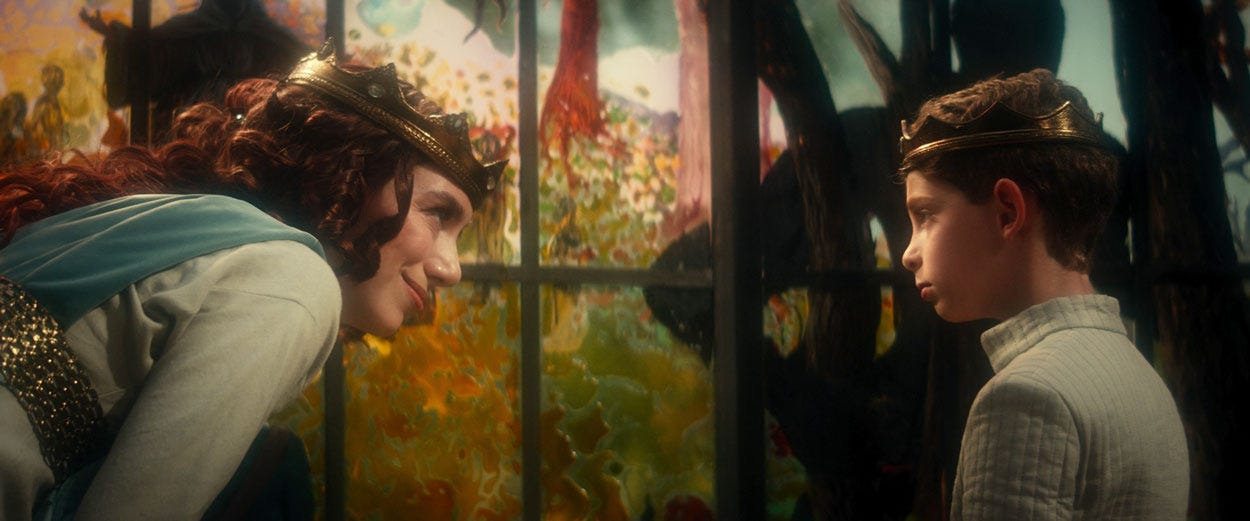
Picard, at this psychiatrist’s insistence, begins telling a story about “a queen with fiery red hair” whose talent for telling stories to her princely son becomes the episode’s secondary framing device, one that permits “Monsters” to flashback to the young Picard, dressed as said prince, standing inside Château Picard’s cupola next to his resplendently attired mother, the Red Queen. Yvette instructs the young Jean-Luc that, as prince, he must inspire people with his speech, assuring him that, despite his doubts, he will eventually succeed in this task because, Yvette/the Red Queen claims, she can see the future.
Yvette paints the scenes of the parable she’s chosen to recite—about a sorcerer who loses his magic just as he’s about to slay a noble prince, a boy who steals the wizard’s powers just before receiving this sorcerer’s killing blow—onto the cupola’s glass panes, only to see them come alive and threaten to consume both queen and prince. They flee to the château’s basement tunnels, where Yvette is set upon and dragged away by a monster whose form remains indistinct, but whose presence helps explain what Episode 1’s fractured memories mean.
Maggs creates a dream within a dream here, as Picard recalls a fable-like narrative about Yvette’s mental illness—suggested during previous installments, but now confirmed—to forward one of Season 2’s most prominent themes, namely how fantasies—whether personal or political—can become nasty realities more frightening than any fiction.
Consider that the reasons why John de Lancie’s trickster-god Q saves Jean-Luc and his La Sirena crewmates from destruction in Episode 1—by moving them into the Confederation’s terrible alternate reality—haven’t always been clear. Q, as usual, chooses not to explain his motives in the simple, direct manner that Picard would prefer, but “Monsters” builds upon details and subtexts included in Year 2’s previous installments, especially Episode 5 (“Fly Me to the Moon”), to suggest that Q’s actions in Picard Season 2 replay his decision from TNG’s Season 6 episode “Tapestry” to preserve Picard’s life while teaching Jean-Luc lessons about how precious that life is.
The trauma of Picard’s youth now becomes visible to every audience member, including Tallinn, who arrives in the Château Picard tunnels while Picard talks with the psychiatrist, all of which occurs inside Jean-Luc’s subconscious mind as he lies prostrate on a clinic bed. This nested narrative structure—a double framing device that never becomes confusing thanks to director Joe Menendez’s and editor Steve Haugen’s good work—parallels Season 2’s master storyline of Q creating a secondary, parallel reality that the crew must survive after their response to encountering a new faction of the Borg Collective (and this sect’s heretofore-unseen Borg Queen) provokes the mission they’re now forced to undertake. Restoring the timeline to its proper trajectory, after all, requires Picard and company to travel into Earth’s past, an action that risks fouling history even more.
“Monsters,” however, operates on a more intimate level than these galaxy-threatening dangers by rewriting Picard’s understanding of his own family. Callis’s psychiatrist reveals himself to be Maurice Picard, Jean-Luc’s father, whose stern traditionalism (as seen in Maurice’s only prior onscreen appearance, played by Clive Church in “Tapestry”) led him to criticize Jean-Luc’s decision to join Starfleet and to provoke lifelong resentment in his son, as seen in the Season 4 TNG segment “Family.”
Since Terry Matalas wouldn’t cast an actor of James Callis’s caliber to play any old role, the opportunity to watch Callis and Patrick Stewart snipe at one another in Episode 7’s early scenes is a treat. This relationship’s changing tenor is equally intriguing, particularly when Jean-Luc softens toward his father’s behavior after realizing that Maurice’s traditionalism, as much as—if not more than—the man’s claims that Yvette wouldn’t accept help for her deteriorating mental health, prevented him from helping her recover.
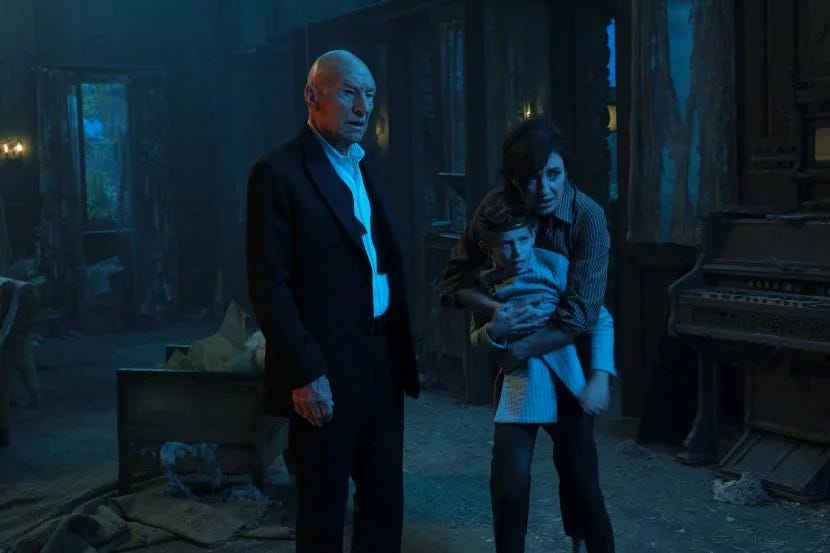
These limitations led Maurice, never a great believer in the advanced technologies and treatments available to 24th-Century humanity, to lock Yvette into a basement room, an act of stunning and hypocritical cruelty meant to protect her from manic mood swings. Despite Jean-Luc’s momentary re-evaluation of his father’s gruff persona late in “Monsters,” Maurice’s actions not only reinforce his image as an uncaring taskmaster but also make me feel even more antipathy toward him.
This response underscores how “Monsters” teeters in its waning minutes. Constructing Maurice as yet another put-upon husband who’s saddled with a crazy wife isn’t the victory of characterization that Maggs and Matalas may think. How many times has American television offered this objectionable—even dreary—plotline over the decades? And why must Star Trek: Picard endorse it?
Let’s just be thankful that Madeline Wise’s expert performance as Yvette remains so fine in its gentle, compassionate, and laudable nuance that Yvette’s psychological struggles appear regrettably authentic, not putatively sexist. Let’s also credit Jean-Luc’s fantasy of the Red Queen reciting a tale about monsters chasing them into Castle/Château Picard’s dingy dungeon as a clever device that visualizes Yvette’s turbulent inner state with more sensitivity than expected. One hopes that dramatizing the terrors of schizophrenia this way helps viewers gain some appreciation for a condition that remains grossly misunderstood by people who’ve never experienced it themselves (or who’ve never lived with someone experiencing it).
Jane Maggs, in other words, brings slight subtlety to the crazy-wife stereotype that “Monsters” invokes, yet she, Terry Matalas, and Picard’s writing staff should’ve worked harder to demolish it. The final images of Madeline trapped inside her locked room—presented as blink-and-you’ll-miss-them flashcuts—suggest that Yvette will take her own life. If true, the way that future installments handle this outcome depends entirely upon whether they travel the route of the touchingly revelatory or the path of the thuddingly hackneyed. Although I’m glad Picard mines its protagonist’s mind to mostly good effect in “Monsters,” let’s pray that Maggs’s and Matalas’s choice to include a type of trauma that’s difficult to portray well produces results that put this uneasiness to rest.
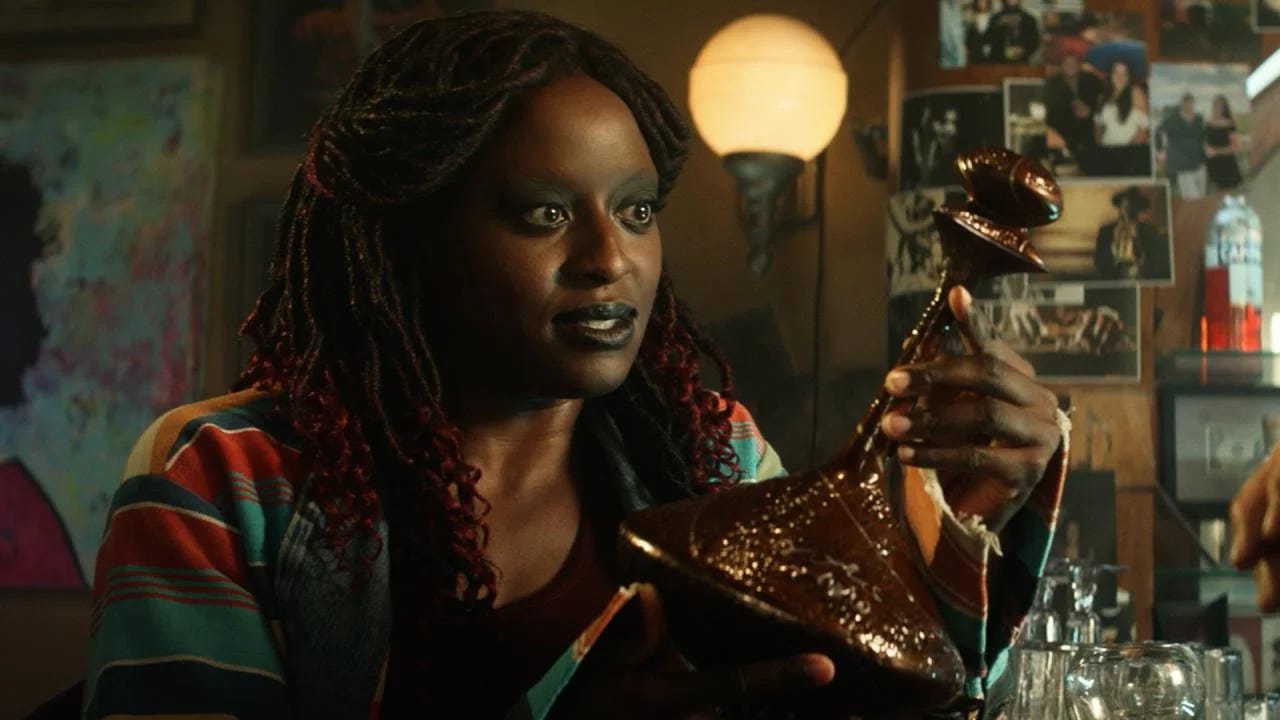
3. In the Mix
My disquiet extends to portions of this episode’s B, C, and D subplots, as well. The B story of Raffi Musiker (Michelle Hurd) and Seven of Nine (Jeri Ryan) tracking the Borg Queen-controlled Agnes Jurati (Alison Pill) through the streets of Los Angeles, only to realize that the Jurati Queen may grow strong enough to assimilate 21st-Century humanity, remains a strictly by-the-numbers affair. Good as Hurd and Ryan are, their scenes remain little more than procedural place-setting for what will presumably become more satisfying meals in Episodes 8, 9, and 10.
The C plot, in which Santiago Cabrera’s fun-loving Cristóbal Rios continues his affectionate jousting with Teresa Ramirez, connects to the A plot (of Tallinn going inside Picard’s mind) only because Jane Maggs must find something for Rios, Ramirez, and her son Ricardo (Steve Gutierrez) to do. Teresa’s enjoyable, take-no-shit banter with Rios includes a particularly amusing moment when, after asking if he’s from outer space, Rios replies, “No, I’m from Chile. I just . . . I work in outer space.”
Longtime Trek fans instantly recognize this exchange as an affectionate homage to the charming interaction between William Shatner’s James T. Kirk and Catherine Hicks’s Dr. Gillian Taylor in 1986’s feature film Star Trek IV: The Voyage Home where, when Taylor asks Kirk a similar question, Kirk drolly replies, “No, I’m from Iowa. I only work in outer space.” Cabrera underplays his riposte’s comedy more than Shatner does, but, even so, please ignore anyone who expresses astonishment that Shatner ever underplayed anything as Kirk despite the actor’s well-deserved reputation for infusing this role with passionate intensity.
Rios, however, chooses to beam Teresa and Ricardo aboard La Sirena in what seems an objectionable decision by a man who earlier expresses concern about preserving the timeline’s integrity. This development telegraphs the fact that, like Gillian Taylor in The Voyage Home, Teresa and Ricardo may choose to travel into the future before Season 2 ends. Another possibility is that Picard will reverse The Voyage Home’s primary violation of temporal propriety (removing people from their own historical era risks all sorts of problems, doesn’t it?) by having Rios remain in 2024.
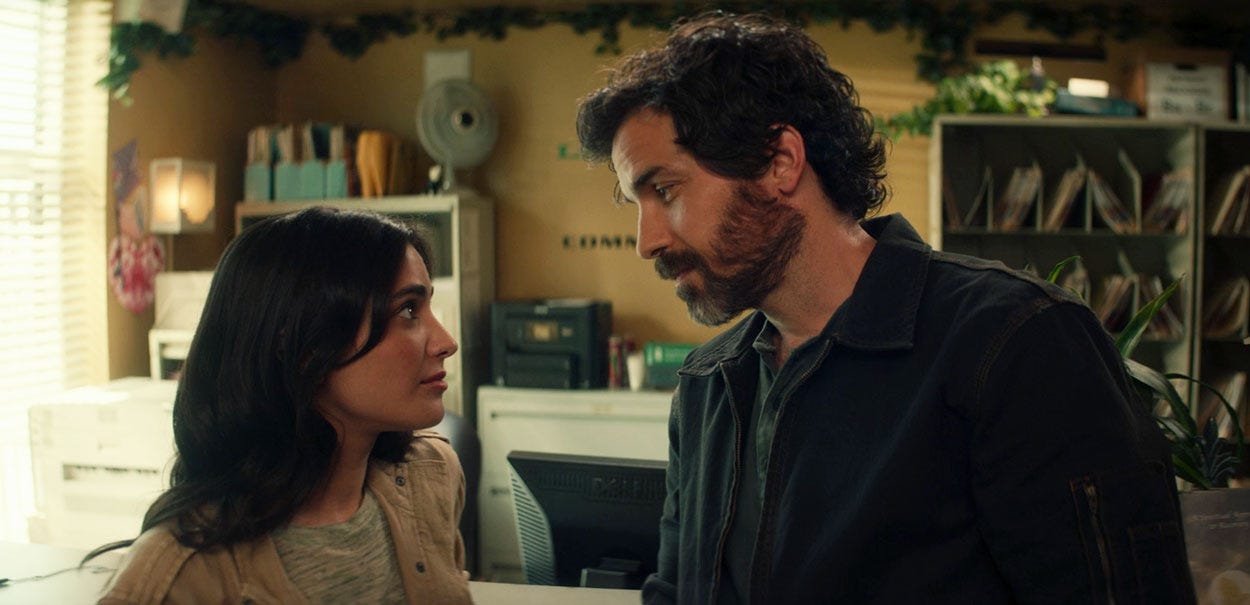
Rios, please recall, tells Raffi at the Europa Mission gala chronicled in “Two of One” that “21st-Century Earth isn’t what I thought it would be. Everything’s so intense. All the cars and the honking and shouting. It’s dirty. Music everywhere. Oh, the food is amazing.” Bringing his love interest aboard his spaceship also parallels Kirk’s choice to beam Gillian aboard the commandeered Klingon Bird of Prey he commands in The Voyage Home. No matter how many Starfleet protocols Rios’s action violates, Star Trek rarely cares about such niceties if abrogating them creates good character moments.
Plus, doing so allows Jane Maggs to give Ricardo this episode’s best line. The boy exclaims “I’m gonna go touch everything!” after materializing on La Sirena’s transporter pad, which is precisely what I would do, so seeing this situation enacted onscreen provokes belly laughs whose levity tries to prepare the audience—tries being the operative word—for Episode 7’s zany conclusion.
Like Agnes Jurati’s “Shadows of the Night” solo in “Two of One,” the final stretch of “Monsters” is among the wackiest sequences ever filmed for a Trek production. Picard awakens from his coma hoping, per Tallinn’s recommendation, to talk with Q and resolve their conflict. Q, however, is nowhere to be found. He can’t or won’t appear when Picard demands that he (Q) do so, causing the good admiral to visit the 10 Forward Avenue bar owned and operated by Guinan. Ito Aghayere, so effective as the younger version of Whoopi Goldberg’s character in Episode 4 (“Watcher”), returns to help Picard summon Q back to 2024 Los Angeles by pulling—deep breaths, everyone, and no, I’m not making this up—the old rub-a-lamp-to-release-a-genie trick. Star Trek: Picard’s take on this Saturday-morning-cartoon staple is so bonkers that, against my better judgment, I can only admire Jane Maggs’s moxie in employing it.
Aghayere and Stewart happily play this scene for all they’re worth, with their eyes twinkling just enough to let us know they’re in on the joke. Yes, dear reader, with Season 2’s conclusion fast approaching, the universe’s fate hanging in the balance, and Q refusing to cooperate, what options are left to our weary time voyagers? Picard has (or thinks he has) little leverage over Q, although refusing to play Q’s game by ceasing any further attempts to right history’s course—an action that would surely get a rise out of Jean-Luc’s mercurial nemesis—either doesn’t occur to Picard or, more likely, he overrules this course of action as too irresponsible given the enormous stakes at hand.
Anyone complaining that American television is too rote, too mundane, or too predictable must confess that they don’t see Young Guinan’s solution coming. She explains that the animosity between her older self and Q (as seen in The Next Generation’s Season 2 classic “Q Who”—the episode that introduces the Borg into the Trek franchise—and Season 3’s “Deja Q”) is shared by their peoples. The El-Aurians believe that unity is best accompanied by good food and drink, leading them, at some point in the past, to establish a truce with the Q Continuum that ends their long cold war. Both species enacted this armistice by capturing its first moment inside an ornate bottle that, fortunately for Picard (and for us), Young Guinan happens to possess. However dodgy this convenience may seem, Young Guinan opens the bottle, drinks the liquid inside, and shrieks to high heaven.
This bit of business is both serious and silly, a tonal paradox that, like the time-travel contradictions threatening to end all existence, typifies Terry Matalas’s tenure as Picard’s showrunner. Aghayere makes this scene work by playing Guinan’s status as Picard’s confidante straight, yet I sympathize with viewers who wonder why Maggs and Matalas choose this moment to address the long-standing mystery about Guinan’s and Q’s backstory. This throwaway disclosure, moreover, fails to achieve its objective even if Picard and Young Guinan don’t wait long before the bar’s door opens and someone descends its stairway entrance.
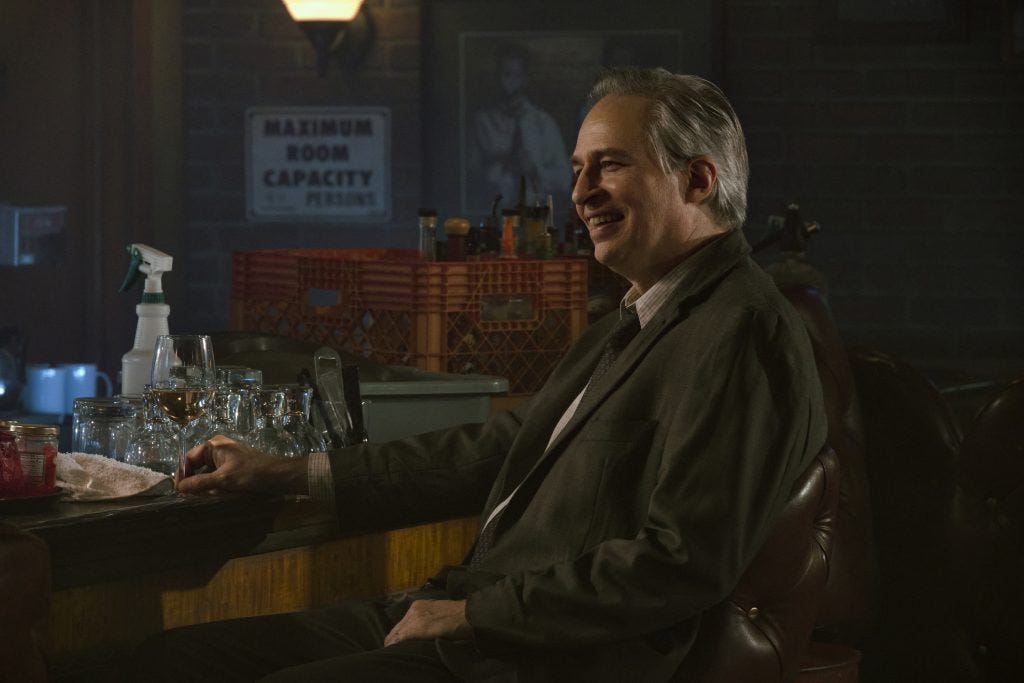
Q doesn’t normally enter scenes or rooms this way, so how happy are fans of Shawn Ryan’s The Shield to see Detective Dutch Wagenbach walk into Picard’s life? Anyone hoping to watch this most unlikely television crossover occur is bound for disappointment no matter how fun imagining Michael Chiklis’s The Shield antihero Vic Mackey crashing into Picard’s world may be.
Even so, seeing Jay Karnes, the actor who plays Wagenbach throughout Ryan’s masterful cop drama, is always welcome. Plus, Karnes shares history with both Terry Matalas and Star Trek, having essayed the role of FBI Agent Robert Gale in five superb 12 Monkeys appearances and, in one of Karnes’s earliest television guest shots, the role of Lieutenant Ducane—second-in-command of the 29th-Century Federation timeship U.S.S. Relativity—in the fifth-season Voyager installment “Relativity.”
Some fans hoped, after set photos of Karnes and Patrick Stewart leaked online, that Ducane would return, but, lovely as this development would be given the temporal shenanigans that Picard Season 2 indulges, the fact that the Federation never exists in the program’s current storyline means that Ducane may not be born unless Picard gets history back on track. Karnes’s Picard character, Martin Wells, first passes himself off as a man searching for liquid relief at the end of a long day, even describing himself as “more of a sci-fi guy” before asking Picard and Young Guinan if they’re “not really the spacey types?,” to which Picard replies, “Most definitely not.”
This fun metatextual nod may help offset the imponderables piling up as “Monsters” comes to a close. Wells confesses to being a federal agent just as armed officers storm the bar to arrest Picard and Young Guinan. Why introduce this character and this storyline so late in Year 2’s narrative game? What do they add to a season already rife with plots, subplots, and recurring characters? “Monsters” stumbles in its final stretch, not because Jane Maggs forgets how to write a proper conclusion for Episode 7, but rather because she’s beholden to whatever plan Terry Matalas designed for Season 2. Jay Karnes, thankfully, is as good as always, while Ito Aghayere and Patrick Stewart never disappoint.
No, the problem (if a problem there be) is that Season 2’s story now feels as if it’s slipped from its creators’ control. Events take on lives of their own, which, however excitingly unpredictable, remains worrisome if Maggs, Matalas, and their writing partners don’t know where Season 2 is going. Travelling into the unknown is a grand Star Trek tradition that holds real value inside the writers’ room, where Matalas and his staff can freely conceive, debate, and refine the stories they wish to tell, but pulling off the creative victory they clearly desire—bringing their season-long temporal narrative to a satisfying conclusion—is, at this point, uncertain.
“Time will tell” is a distressingly on-the-nose bromide upon which to conclude this review of “Monsters,” particularly since the episode is so good in so many other ways, but that’s where we find ourselves as Episode 7 reaches the finish line. Let’s pray that Episode 8, titled “Mercy,” lives up to its title by flawlessly melding serialized drama with episodic television’s talent for vignettes. “Monsters” may not do so, but such a blemish can’t—and shouldn’t—obscure the strengths on display in a worthwhile, if unusual, installment.
So, two cheers—but not three—for “Monsters.” Let’s hope that, as Season 2 bounds into its final act, Star Trek: Picard follows a steadier and sturdier course.
NOTES
No matter how stridently some audience members bridle at what they perceive as departures from Trek’s established history, Gene Roddenberry never fretted over these inconsistencies as much as these fans do/did. Once The Original Series went into daily syndication during the early 1970s, with hundreds of television stations across the United States rerunning all 79 episodes in whatever time slots they wanted, the show’s popularity surged, leading to the production of The Animated Series, the publication of authorized Star Trek novels telling brand-new stories about the U.S.S. Enterprise’s (NCC-1701’s) crew, and, eventually, the 1979 release of Star Trek: The Motion Picture.
Trek’s most ardent admirers, moreover, didn’t consider as carefully as they might have the religious roots and resonances of the term canon before employing it to describe the franchise’s increasingly complex lore. Indeed, these audience members too rarely acknowledge the truth that TOS’s production staff didn’t worry overmuch about the series’ internal continuity, with Star Trek’s first season manifesting many discrepancies—if not outright contradictions—in its characters’ behavior, the Enterprise’s design, and, especially, the identity of the political union that the Enterprise represents.
“The Federation,” for instance, isn’t mentioned until the 19th episode (“Arena”), while the full designation “the United Federation of Planets” first appears in the 23rd episode (“A Taste of Armageddon”). Both “Charlie X” (Episode 7) and “Tomorrow Is Yesterday” (Episode 21) refer to the “United Earth Space Probe Agency” as the organization that operates the Enterprise, with the term “Starfleet” not appearing until the teleplay for “Court Martial” (Episode 14) was written. The word “Starfleet,” moreover, isn’t uttered onscreen until Season 1’s two-part installment “The Menagerie” (Episodes 15 and 16), Roddenberry’s ingenious paste-up of TOS’s unaired first pilot episode, 1964’s “The Cage.” “The Menagerie,” indeed, was broadcast before “Court Martial” despite being filmed after it.
Roddenberry, to add grist to this particular mill, wasn’t unduly concerned about tying up loose narrative ends, either, as the evolving backstories of Spock and the Vulcan people (or the Vulcanians, as they’re called sporadically throughout TOS’s first season) demonstrate, to say nothing of The Motion Picture including new Starfleet uniforms, different technology, and, most famously, the Klingons’ altered appearance (including forehead ridges never seen in TOS) without a word of explanation.
Ira Steven Behr so jovially discusses the production of “Captain’s Holiday” in the Season 3 TNG Blu-ray documentary “Resistance Is Futile—Assimilating Star Trek: The Next Generation: Part 2, Technological Distinctiveness” that his anecdotes about Gene Roddenberry’s and Patrick Stewart’s objections to his (Behr’s) original premise for this episode—in which Picard would face his greatest fear, namely leaving the Enterprise-D to become a Starfleet admiral—are as entertaining as the episode itself.

